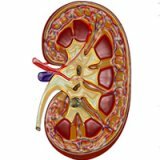Normal temperature in infants: normal and cause subfebrile condition
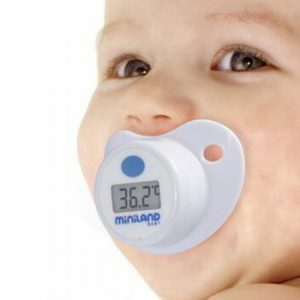
After the young mother returns with the baby from the maternity hospital, she has a huge number of worries.Care for crumbs takes a huge amount of strength and attention.One of the main questions that any mother is asking is the normal body temperature of the baby, and why can it increase?In this case, the concept of "norm" is rather arbitrary, and it is not necessary to panic if you see on the thermometer scale values above or below 36.6 °.
Important: normal parameters for the first days
Table of contents: Features of the newborn's body What is the temperature of the baby How is the temperature measured for small children?Probable causes of subfebrile in children What should I do if my baby has a fever?Features of the newborn
In adults, temperature changes are not significant in normal, and in children they have a sufficiently large amplitude of oscillations. For small children, small differences in the values are in the order of things, since their thermoregulation is not yet perfect, and the heat transfer prevails over the
heat production.Excess heat of the body gives up by convection from the surface of the skin, the evaporation of moisture during sweating, as well as during the exhalation of air.Babies need some time to adapt to environmental conditions.In a month-old baby, the temperature can vary from 36.3 ° C to 37.1 ° C for one day, and this is not considered a pathology.The lowest rates are fixed at 4-5 am, and the highest at 16-17 hours.The diurnal "spread" often reaches 0.9 ° C at the age of 9 months, and by the age of 2 it can be even somewhat larger.
Please note: are important signs that the baby has begun to freeze, is the cooling of his hands and feet, and also hiccups.If these symptoms occur, immediately warm the baby!
What is the temperature of the child of the 1st year of life?
Although the body temperature of the baby is somewhat labile, there are certain limits within which it can fluctuate.
Values that should not cause much concern to the mother - from 36.3 ° to 37.5 ° C. Normally, in the evening, the temperature rises by a few tenths of a degree, but it goes down while the baby is asleep.In the morning hours, the mercury column usually does not rise above the 37.0 ° C mark.
How is the temperature measured for young children?
Important: it is advisable to use an electronic or infrared thermometer, since a mercury can break if accidentally dropped.In addition, the glass case of the latter baby can be damaged by sudden movement.
The main methods of temperature measurement are:
- axillary;
- rectal;
- oral;
- in the ear cavity.
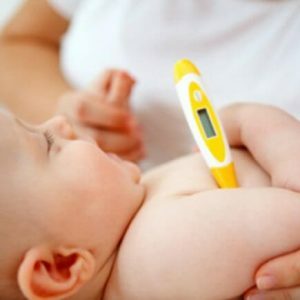 The most common method is when the thermometer is placed in the axillary hollow of the .The thermometer is inserted under the baby's handle( making sure that the skin is not sweaty) and tightly pressed.The results are evaluated after 5-7 minutes.It is important that the device contacts only the skin of the child, but not with clothing;Otherwise the readings will be distorted.
The most common method is when the thermometer is placed in the axillary hollow of the .The thermometer is inserted under the baby's handle( making sure that the skin is not sweaty) and tightly pressed.The results are evaluated after 5-7 minutes.It is important that the device contacts only the skin of the child, but not with clothing;Otherwise the readings will be distorted.
The rectal method involves the introduction of a thermometer into the rectum of the infant .The baby should be placed on his knees so that his legs hang, and insert the thermometer into his anus, previously lubricated with baby cream( to minimize discomfort).Removing the device, and evaluate the results can be in 3-5 minutes.
With the oral method, the thermometer is placed in the mouth of the baby .It is important to hold the thermometer and monitor its position so that the child does not accidentally swallow it when inhaling, and does not push out with the tongue.
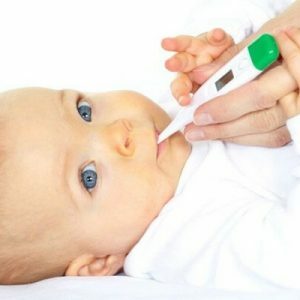 Measurement of the temperature in the ear canal( using an infrared thermometer) does not provide reliable results in children under 3 months due to certain metabolic peculiarities of .The data are also distorted by local inflammation( if otitis develops).
Measurement of the temperature in the ear canal( using an infrared thermometer) does not provide reliable results in children under 3 months due to certain metabolic peculiarities of .The data are also distorted by local inflammation( if otitis develops).
Important: in a person in the rectum the temperature is higher than in the armpit.The difference is up to 1 degree.In the oral method of measurement, on the contrary, it is possible to obtain several underreported data.In the ear cavity, the temperature is higher than under the arm by 0.6-1.2 degrees.
Standards for different measuring methods:
- axillary - 36.0 ° -37.3 ° C;
- rectal - 36,9 ° -38 ° C;
- oral - 36,6 ° -37,2 ° C
Probable causes of subfebrile state in children
Note: is a subfebrile condition, which is an increase in body temperature within 38.0 ° С.
If the temperature is above normal, the general condition of the children usually also changes.The child becomes restless, often crying, and refuses to eat( or eats very little).His skin can be hot to the touch.Sweating is often observed, but the pulse is rapid.Many children have a broken sleep - they do not sleep well, and often wake up at night.
Of course, the most unpleasant cause of fever is infection.In newborn children, very weak immunity, so even a slight cold, which the adult does not notice, can turn into a serious problem for the baby. Subfebrile for a long time can be caused by a chronic inflammatory process.
A common cause of fever in babies is teething .It begins on average at 6 months of age.In addition to hyperthermia, the child has restless behavior, disturbed sleep, increased salivation, fever, swelling, and reddening of the gums.Diarrhea often develops.In this period, the temperature can rise by 2 degrees or more.
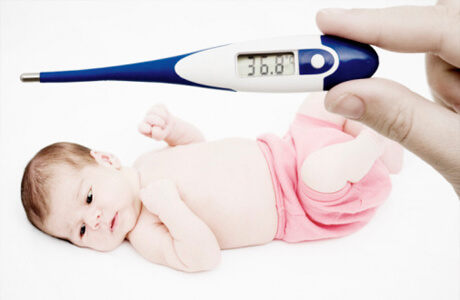
Note: heat is not a pathology, but only one of the symptoms of certain processes occurring in the body.Hyperthermia accelerates biochemical reactions, during which the biosynthesis of natural defenders of the body - interferons - is accelerated.In addition, the elevated temperature itself is fatal to a number of infectious agents.
A fairly common cause of the rise in the overall temperature of a baby is its overheating of the .If the outdoors or in the room is hot, and( or) the baby is wrapped up not in the weather, on the thermometer, most likely, there will be figures exceeding the norm.
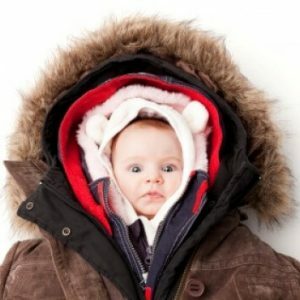 Another reason for the subfebrile state is often the reaction to vaccinations( for example - the introduction of DTP). A foreign biological material is introduced into the body of the child, which causes an active reaction from the immune system.It is almost the same as with any viral infection, so a slight increase in temperature within a few days after vaccination is regarded as a norm.
Another reason for the subfebrile state is often the reaction to vaccinations( for example - the introduction of DTP). A foreign biological material is introduced into the body of the child, which causes an active reaction from the immune system.It is almost the same as with any viral infection, so a slight increase in temperature within a few days after vaccination is regarded as a norm.
In rare cases, hyperthermia becomes a signal of failure of the endocrine glands, the development of autoimmune processes, or the initiation of an oncological process.If a baby has no apparent cause for a long time holding a fever - this is the basis for a comprehensive diagnosis.
What if I have a fever?
Performance from 38 ° C and above is a cause for concern.In such cases it is necessary to contact the pediatrician .Febrile values (38 ° -39 ° C) are an excuse for calling an ambulance brigade, especially if the temperature can not be knocked down by ourselves. Remember that hyperthermia can trigger seizures of .
Even if there are strong assumptions that hyperthermia is caused by teething, you still need to show the baby to the doctor.Chills, hypersalivation, capriciousness and other clinical signs are typical for many dangerous infections.Do not take risks, and "write off" the teeth heat and other symptoms.
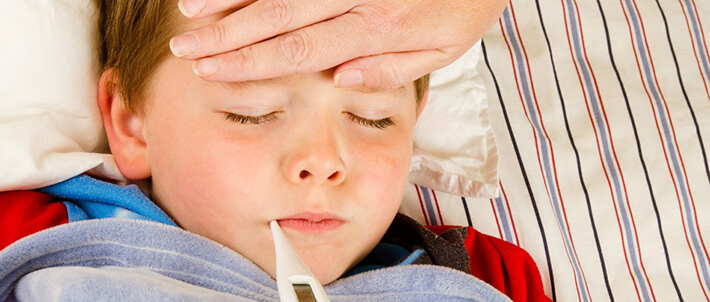
The temperature in young children should be brought down if the values exceed 38 ° С.At smaller figures - only at obvious deterioration of the general condition.
It is not recommended to start with antipyretic medicines and rectal suppositories, but with rubbing. For their conduct you need to take the usual cool water.The child should be given plenty of water to avoid dehydration;It is important that the baby is often applied to the breast.
It is recommended to watch a video of Dr. Komarovsky, in which he tells how to knock down the temperature of a child without medication:
If conservative measures do not give the expected effect, you can resort to medications.The most safe and effective antipyretic and analgesic drug is children's Paracetamol.
Important: in no case do self-medication if the crumbs have those or other chronic diseases( especially - the nervous and cardiovascular system)!
About effective antipyretic drugs for children tells Dr. Komarovsky :
How to maintain the normal temperature of the baby?
There are simple ways to prevent both overheating and hypothermia of a young child.
The temperature in the room where the baby is located must be between + 18 ° and + 22 ° C.
Clothing for the child must be "by season" - the same number of layers, as much on the adult plus one more.
Covering the crumb is preferably a blanket made of natural materials - cotton or wool;This will ensure optimal thermoregulation and help avoid overheating.
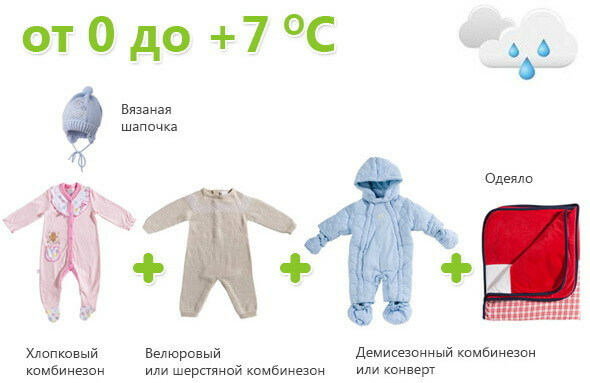
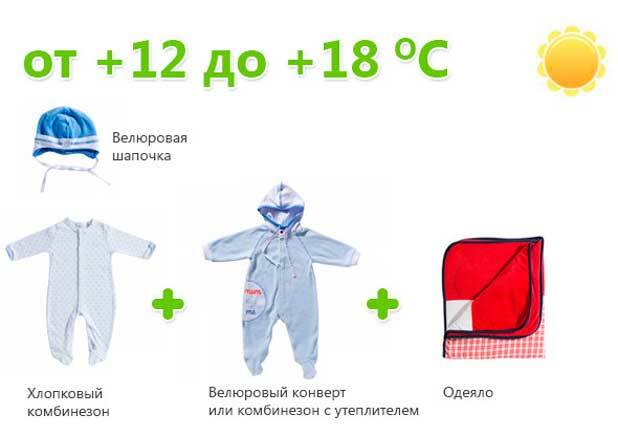
It is desirable that the room always has a wall or desktop thermometer;With its help you can adjust the temperature.
In summer( hot weather), only the cotton coat is put on the baby, and covered with a usual sheet.
During walks, do not move the stroller to the sunny side.
Even in the shadows, you do not need to leave the stroller permanently.
The head of the baby should be covered with a cap or panama.
Important: never leave your baby in a closed vehicle!Remember that overheating sometimes causes children to die!
Plisov Vladimir, medical reviewer



